National Portrait Gallery: Operations, Strategy, and Stakeholders
VerifiedAdded on 2023/01/12
|11
|3243
|72
Report
AI Summary
This report provides a comprehensive analysis of the National Portrait Gallery, a prominent British public institution. It begins with an overview of the gallery, including its history, strategic objectives, and operational focus. The report examines the gallery's commitment to sustainability, detailing its efforts to reduce environmental impact and adhere to the Climate Change Act 2008. It also analyzes the financial operations, highlighting revenue sources, fundraising efforts, and corporate support. The report then shifts to a stakeholder analysis, identifying key stakeholders such as employees, management, government, and customers, and assessing their influence and interests using a stakeholder matrix. The report concludes by summarizing the gallery's significance and providing insights into its operations and management practices.

Hospitality, Tourism, Events
Environment
Environment
Paraphrase This Document
Need a fresh take? Get an instant paraphrase of this document with our AI Paraphraser
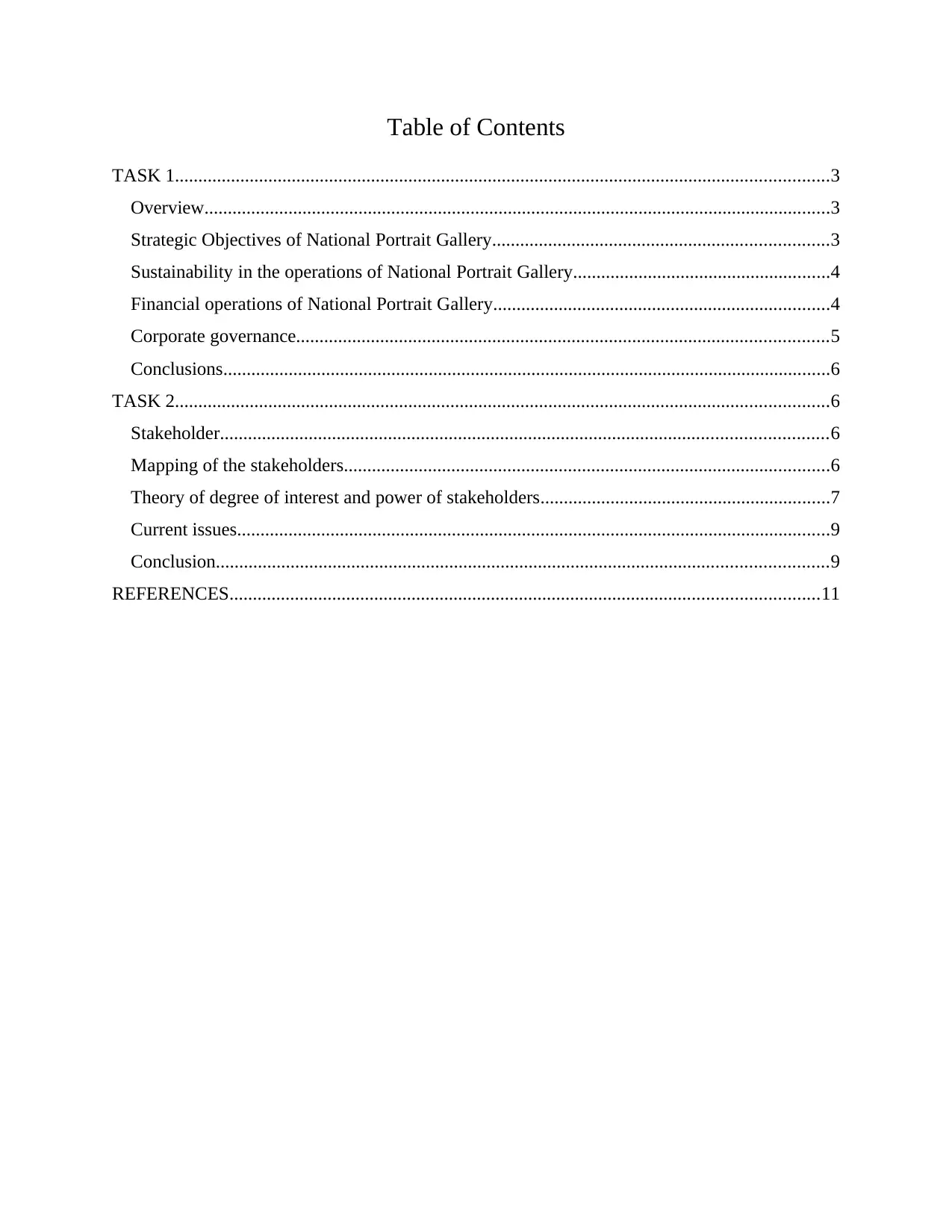
Table of Contents
TASK 1............................................................................................................................................3
Overview......................................................................................................................................3
Strategic Objectives of National Portrait Gallery........................................................................3
Sustainability in the operations of National Portrait Gallery.......................................................4
Financial operations of National Portrait Gallery........................................................................4
Corporate governance..................................................................................................................5
Conclusions..................................................................................................................................6
TASK 2............................................................................................................................................6
Stakeholder..................................................................................................................................6
Mapping of the stakeholders........................................................................................................6
Theory of degree of interest and power of stakeholders..............................................................7
Current issues...............................................................................................................................9
Conclusion...................................................................................................................................9
REFERENCES..............................................................................................................................11
TASK 1............................................................................................................................................3
Overview......................................................................................................................................3
Strategic Objectives of National Portrait Gallery........................................................................3
Sustainability in the operations of National Portrait Gallery.......................................................4
Financial operations of National Portrait Gallery........................................................................4
Corporate governance..................................................................................................................5
Conclusions..................................................................................................................................6
TASK 2............................................................................................................................................6
Stakeholder..................................................................................................................................6
Mapping of the stakeholders........................................................................................................6
Theory of degree of interest and power of stakeholders..............................................................7
Current issues...............................................................................................................................9
Conclusion...................................................................................................................................9
REFERENCES..............................................................................................................................11
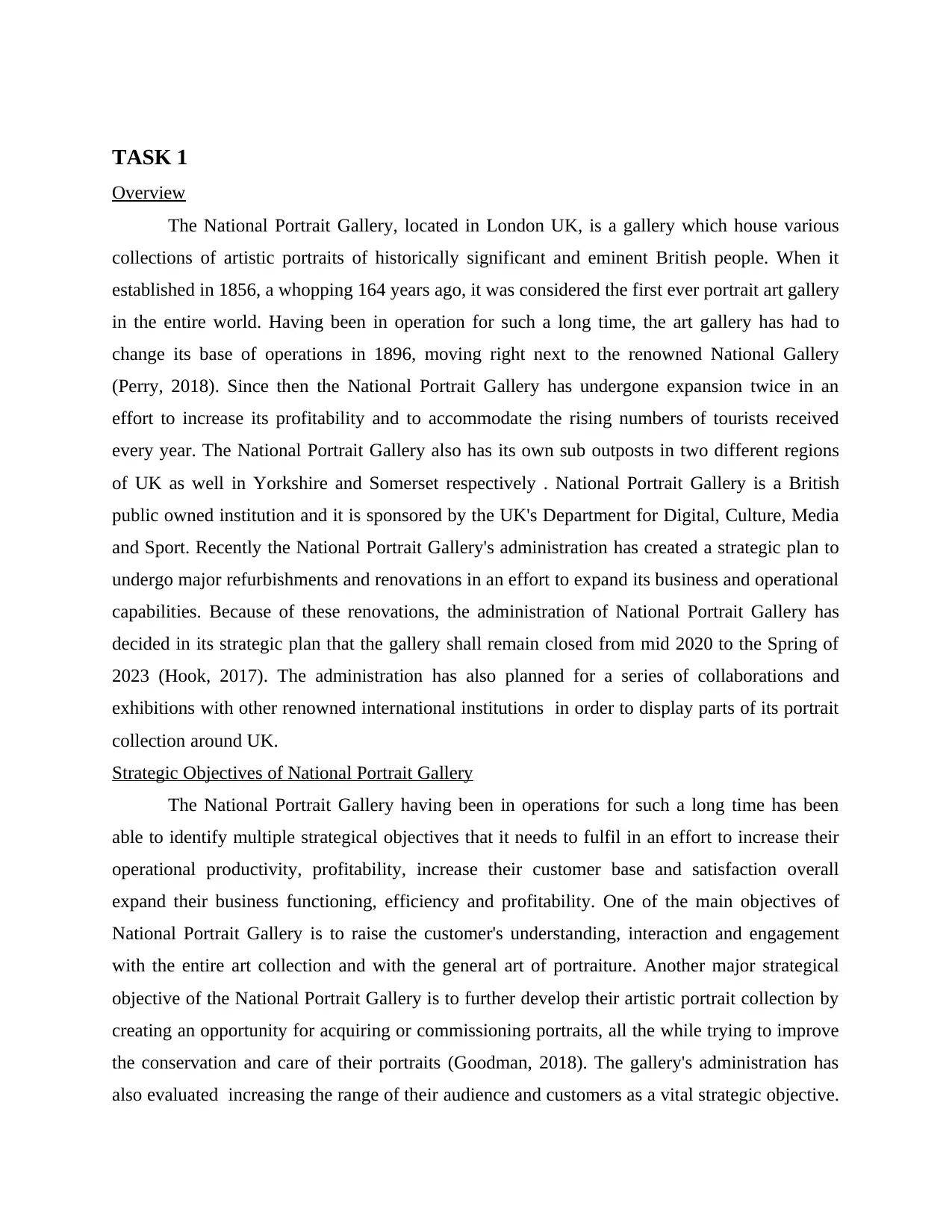
TASK 1
Overview
The National Portrait Gallery, located in London UK, is a gallery which house various
collections of artistic portraits of historically significant and eminent British people. When it
established in 1856, a whopping 164 years ago, it was considered the first ever portrait art gallery
in the entire world. Having been in operation for such a long time, the art gallery has had to
change its base of operations in 1896, moving right next to the renowned National Gallery
(Perry, 2018). Since then the National Portrait Gallery has undergone expansion twice in an
effort to increase its profitability and to accommodate the rising numbers of tourists received
every year. The National Portrait Gallery also has its own sub outposts in two different regions
of UK as well in Yorkshire and Somerset respectively . National Portrait Gallery is a British
public owned institution and it is sponsored by the UK's Department for Digital, Culture, Media
and Sport. Recently the National Portrait Gallery's administration has created a strategic plan to
undergo major refurbishments and renovations in an effort to expand its business and operational
capabilities. Because of these renovations, the administration of National Portrait Gallery has
decided in its strategic plan that the gallery shall remain closed from mid 2020 to the Spring of
2023 (Hook, 2017). The administration has also planned for a series of collaborations and
exhibitions with other renowned international institutions in order to display parts of its portrait
collection around UK.
Strategic Objectives of National Portrait Gallery
The National Portrait Gallery having been in operations for such a long time has been
able to identify multiple strategical objectives that it needs to fulfil in an effort to increase their
operational productivity, profitability, increase their customer base and satisfaction overall
expand their business functioning, efficiency and profitability. One of the main objectives of
National Portrait Gallery is to raise the customer's understanding, interaction and engagement
with the entire art collection and with the general art of portraiture. Another major strategical
objective of the National Portrait Gallery is to further develop their artistic portrait collection by
creating an opportunity for acquiring or commissioning portraits, all the while trying to improve
the conservation and care of their portraits (Goodman, 2018). The gallery's administration has
also evaluated increasing the range of their audience and customers as a vital strategic objective.
Overview
The National Portrait Gallery, located in London UK, is a gallery which house various
collections of artistic portraits of historically significant and eminent British people. When it
established in 1856, a whopping 164 years ago, it was considered the first ever portrait art gallery
in the entire world. Having been in operation for such a long time, the art gallery has had to
change its base of operations in 1896, moving right next to the renowned National Gallery
(Perry, 2018). Since then the National Portrait Gallery has undergone expansion twice in an
effort to increase its profitability and to accommodate the rising numbers of tourists received
every year. The National Portrait Gallery also has its own sub outposts in two different regions
of UK as well in Yorkshire and Somerset respectively . National Portrait Gallery is a British
public owned institution and it is sponsored by the UK's Department for Digital, Culture, Media
and Sport. Recently the National Portrait Gallery's administration has created a strategic plan to
undergo major refurbishments and renovations in an effort to expand its business and operational
capabilities. Because of these renovations, the administration of National Portrait Gallery has
decided in its strategic plan that the gallery shall remain closed from mid 2020 to the Spring of
2023 (Hook, 2017). The administration has also planned for a series of collaborations and
exhibitions with other renowned international institutions in order to display parts of its portrait
collection around UK.
Strategic Objectives of National Portrait Gallery
The National Portrait Gallery having been in operations for such a long time has been
able to identify multiple strategical objectives that it needs to fulfil in an effort to increase their
operational productivity, profitability, increase their customer base and satisfaction overall
expand their business functioning, efficiency and profitability. One of the main objectives of
National Portrait Gallery is to raise the customer's understanding, interaction and engagement
with the entire art collection and with the general art of portraiture. Another major strategical
objective of the National Portrait Gallery is to further develop their artistic portrait collection by
creating an opportunity for acquiring or commissioning portraits, all the while trying to improve
the conservation and care of their portraits (Goodman, 2018). The gallery's administration has
also evaluated increasing the range of their audience and customers as a vital strategic objective.
⊘ This is a preview!⊘
Do you want full access?
Subscribe today to unlock all pages.

Trusted by 1+ million students worldwide
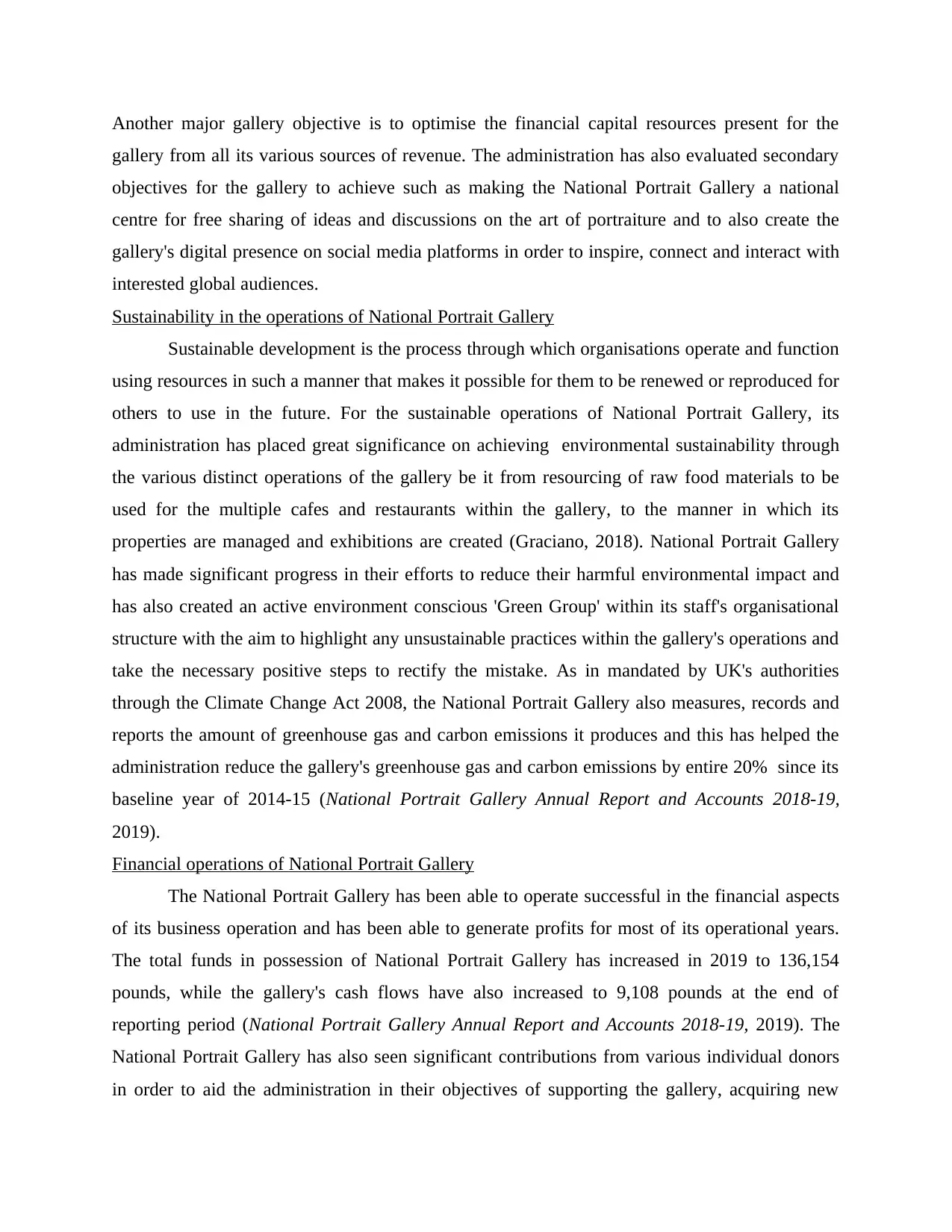
Another major gallery objective is to optimise the financial capital resources present for the
gallery from all its various sources of revenue. The administration has also evaluated secondary
objectives for the gallery to achieve such as making the National Portrait Gallery a national
centre for free sharing of ideas and discussions on the art of portraiture and to also create the
gallery's digital presence on social media platforms in order to inspire, connect and interact with
interested global audiences.
Sustainability in the operations of National Portrait Gallery
Sustainable development is the process through which organisations operate and function
using resources in such a manner that makes it possible for them to be renewed or reproduced for
others to use in the future. For the sustainable operations of National Portrait Gallery, its
administration has placed great significance on achieving environmental sustainability through
the various distinct operations of the gallery be it from resourcing of raw food materials to be
used for the multiple cafes and restaurants within the gallery, to the manner in which its
properties are managed and exhibitions are created (Graciano, 2018). National Portrait Gallery
has made significant progress in their efforts to reduce their harmful environmental impact and
has also created an active environment conscious 'Green Group' within its staff's organisational
structure with the aim to highlight any unsustainable practices within the gallery's operations and
take the necessary positive steps to rectify the mistake. As in mandated by UK's authorities
through the Climate Change Act 2008, the National Portrait Gallery also measures, records and
reports the amount of greenhouse gas and carbon emissions it produces and this has helped the
administration reduce the gallery's greenhouse gas and carbon emissions by entire 20% since its
baseline year of 2014-15 (National Portrait Gallery Annual Report and Accounts 2018-19,
2019).
Financial operations of National Portrait Gallery
The National Portrait Gallery has been able to operate successful in the financial aspects
of its business operation and has been able to generate profits for most of its operational years.
The total funds in possession of National Portrait Gallery has increased in 2019 to 136,154
pounds, while the gallery's cash flows have also increased to 9,108 pounds at the end of
reporting period (National Portrait Gallery Annual Report and Accounts 2018-19, 2019). The
National Portrait Gallery has also seen significant contributions from various individual donors
in order to aid the administration in their objectives of supporting the gallery, acquiring new
gallery from all its various sources of revenue. The administration has also evaluated secondary
objectives for the gallery to achieve such as making the National Portrait Gallery a national
centre for free sharing of ideas and discussions on the art of portraiture and to also create the
gallery's digital presence on social media platforms in order to inspire, connect and interact with
interested global audiences.
Sustainability in the operations of National Portrait Gallery
Sustainable development is the process through which organisations operate and function
using resources in such a manner that makes it possible for them to be renewed or reproduced for
others to use in the future. For the sustainable operations of National Portrait Gallery, its
administration has placed great significance on achieving environmental sustainability through
the various distinct operations of the gallery be it from resourcing of raw food materials to be
used for the multiple cafes and restaurants within the gallery, to the manner in which its
properties are managed and exhibitions are created (Graciano, 2018). National Portrait Gallery
has made significant progress in their efforts to reduce their harmful environmental impact and
has also created an active environment conscious 'Green Group' within its staff's organisational
structure with the aim to highlight any unsustainable practices within the gallery's operations and
take the necessary positive steps to rectify the mistake. As in mandated by UK's authorities
through the Climate Change Act 2008, the National Portrait Gallery also measures, records and
reports the amount of greenhouse gas and carbon emissions it produces and this has helped the
administration reduce the gallery's greenhouse gas and carbon emissions by entire 20% since its
baseline year of 2014-15 (National Portrait Gallery Annual Report and Accounts 2018-19,
2019).
Financial operations of National Portrait Gallery
The National Portrait Gallery has been able to operate successful in the financial aspects
of its business operation and has been able to generate profits for most of its operational years.
The total funds in possession of National Portrait Gallery has increased in 2019 to 136,154
pounds, while the gallery's cash flows have also increased to 9,108 pounds at the end of
reporting period (National Portrait Gallery Annual Report and Accounts 2018-19, 2019). The
National Portrait Gallery has also seen significant contributions from various individual donors
in order to aid the administration in their objectives of supporting the gallery, acquiring new
Paraphrase This Document
Need a fresh take? Get an instant paraphrase of this document with our AI Paraphraser
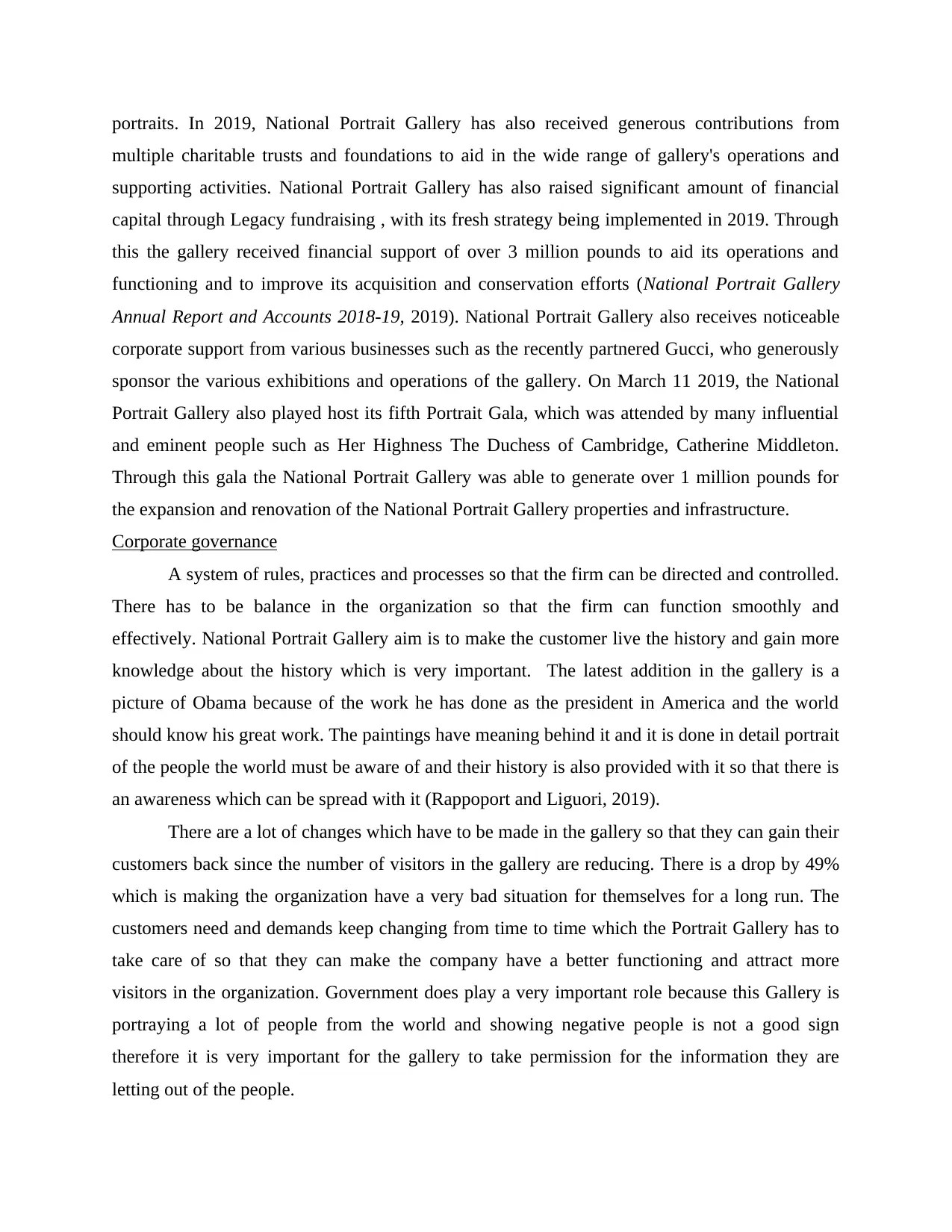
portraits. In 2019, National Portrait Gallery has also received generous contributions from
multiple charitable trusts and foundations to aid in the wide range of gallery's operations and
supporting activities. National Portrait Gallery has also raised significant amount of financial
capital through Legacy fundraising , with its fresh strategy being implemented in 2019. Through
this the gallery received financial support of over 3 million pounds to aid its operations and
functioning and to improve its acquisition and conservation efforts (National Portrait Gallery
Annual Report and Accounts 2018-19, 2019). National Portrait Gallery also receives noticeable
corporate support from various businesses such as the recently partnered Gucci, who generously
sponsor the various exhibitions and operations of the gallery. On March 11 2019, the National
Portrait Gallery also played host its fifth Portrait Gala, which was attended by many influential
and eminent people such as Her Highness The Duchess of Cambridge, Catherine Middleton.
Through this gala the National Portrait Gallery was able to generate over 1 million pounds for
the expansion and renovation of the National Portrait Gallery properties and infrastructure.
Corporate governance
A system of rules, practices and processes so that the firm can be directed and controlled.
There has to be balance in the organization so that the firm can function smoothly and
effectively. National Portrait Gallery aim is to make the customer live the history and gain more
knowledge about the history which is very important. The latest addition in the gallery is a
picture of Obama because of the work he has done as the president in America and the world
should know his great work. The paintings have meaning behind it and it is done in detail portrait
of the people the world must be aware of and their history is also provided with it so that there is
an awareness which can be spread with it (Rappoport and Liguori, 2019).
There are a lot of changes which have to be made in the gallery so that they can gain their
customers back since the number of visitors in the gallery are reducing. There is a drop by 49%
which is making the organization have a very bad situation for themselves for a long run. The
customers need and demands keep changing from time to time which the Portrait Gallery has to
take care of so that they can make the company have a better functioning and attract more
visitors in the organization. Government does play a very important role because this Gallery is
portraying a lot of people from the world and showing negative people is not a good sign
therefore it is very important for the gallery to take permission for the information they are
letting out of the people.
multiple charitable trusts and foundations to aid in the wide range of gallery's operations and
supporting activities. National Portrait Gallery has also raised significant amount of financial
capital through Legacy fundraising , with its fresh strategy being implemented in 2019. Through
this the gallery received financial support of over 3 million pounds to aid its operations and
functioning and to improve its acquisition and conservation efforts (National Portrait Gallery
Annual Report and Accounts 2018-19, 2019). National Portrait Gallery also receives noticeable
corporate support from various businesses such as the recently partnered Gucci, who generously
sponsor the various exhibitions and operations of the gallery. On March 11 2019, the National
Portrait Gallery also played host its fifth Portrait Gala, which was attended by many influential
and eminent people such as Her Highness The Duchess of Cambridge, Catherine Middleton.
Through this gala the National Portrait Gallery was able to generate over 1 million pounds for
the expansion and renovation of the National Portrait Gallery properties and infrastructure.
Corporate governance
A system of rules, practices and processes so that the firm can be directed and controlled.
There has to be balance in the organization so that the firm can function smoothly and
effectively. National Portrait Gallery aim is to make the customer live the history and gain more
knowledge about the history which is very important. The latest addition in the gallery is a
picture of Obama because of the work he has done as the president in America and the world
should know his great work. The paintings have meaning behind it and it is done in detail portrait
of the people the world must be aware of and their history is also provided with it so that there is
an awareness which can be spread with it (Rappoport and Liguori, 2019).
There are a lot of changes which have to be made in the gallery so that they can gain their
customers back since the number of visitors in the gallery are reducing. There is a drop by 49%
which is making the organization have a very bad situation for themselves for a long run. The
customers need and demands keep changing from time to time which the Portrait Gallery has to
take care of so that they can make the company have a better functioning and attract more
visitors in the organization. Government does play a very important role because this Gallery is
portraying a lot of people from the world and showing negative people is not a good sign
therefore it is very important for the gallery to take permission for the information they are
letting out of the people.
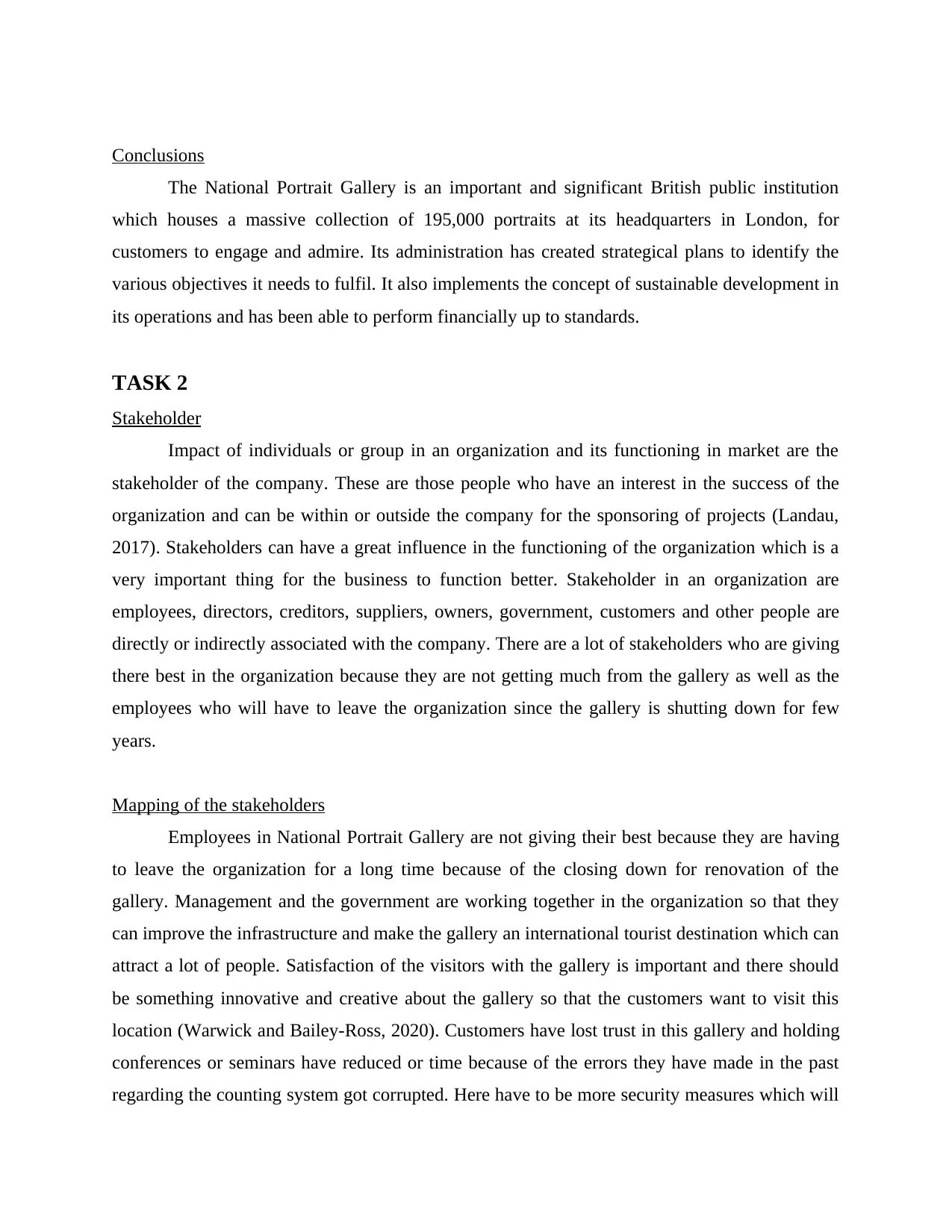
Conclusions
The National Portrait Gallery is an important and significant British public institution
which houses a massive collection of 195,000 portraits at its headquarters in London, for
customers to engage and admire. Its administration has created strategical plans to identify the
various objectives it needs to fulfil. It also implements the concept of sustainable development in
its operations and has been able to perform financially up to standards.
TASK 2
Stakeholder
Impact of individuals or group in an organization and its functioning in market are the
stakeholder of the company. These are those people who have an interest in the success of the
organization and can be within or outside the company for the sponsoring of projects (Landau,
2017). Stakeholders can have a great influence in the functioning of the organization which is a
very important thing for the business to function better. Stakeholder in an organization are
employees, directors, creditors, suppliers, owners, government, customers and other people are
directly or indirectly associated with the company. There are a lot of stakeholders who are giving
there best in the organization because they are not getting much from the gallery as well as the
employees who will have to leave the organization since the gallery is shutting down for few
years.
Mapping of the stakeholders
Employees in National Portrait Gallery are not giving their best because they are having
to leave the organization for a long time because of the closing down for renovation of the
gallery. Management and the government are working together in the organization so that they
can improve the infrastructure and make the gallery an international tourist destination which can
attract a lot of people. Satisfaction of the visitors with the gallery is important and there should
be something innovative and creative about the gallery so that the customers want to visit this
location (Warwick and Bailey-Ross, 2020). Customers have lost trust in this gallery and holding
conferences or seminars have reduced or time because of the errors they have made in the past
regarding the counting system got corrupted. Here have to be more security measures which will
The National Portrait Gallery is an important and significant British public institution
which houses a massive collection of 195,000 portraits at its headquarters in London, for
customers to engage and admire. Its administration has created strategical plans to identify the
various objectives it needs to fulfil. It also implements the concept of sustainable development in
its operations and has been able to perform financially up to standards.
TASK 2
Stakeholder
Impact of individuals or group in an organization and its functioning in market are the
stakeholder of the company. These are those people who have an interest in the success of the
organization and can be within or outside the company for the sponsoring of projects (Landau,
2017). Stakeholders can have a great influence in the functioning of the organization which is a
very important thing for the business to function better. Stakeholder in an organization are
employees, directors, creditors, suppliers, owners, government, customers and other people are
directly or indirectly associated with the company. There are a lot of stakeholders who are giving
there best in the organization because they are not getting much from the gallery as well as the
employees who will have to leave the organization since the gallery is shutting down for few
years.
Mapping of the stakeholders
Employees in National Portrait Gallery are not giving their best because they are having
to leave the organization for a long time because of the closing down for renovation of the
gallery. Management and the government are working together in the organization so that they
can improve the infrastructure and make the gallery an international tourist destination which can
attract a lot of people. Satisfaction of the visitors with the gallery is important and there should
be something innovative and creative about the gallery so that the customers want to visit this
location (Warwick and Bailey-Ross, 2020). Customers have lost trust in this gallery and holding
conferences or seminars have reduced or time because of the errors they have made in the past
regarding the counting system got corrupted. Here have to be more security measures which will
⊘ This is a preview!⊘
Do you want full access?
Subscribe today to unlock all pages.

Trusted by 1+ million students worldwide
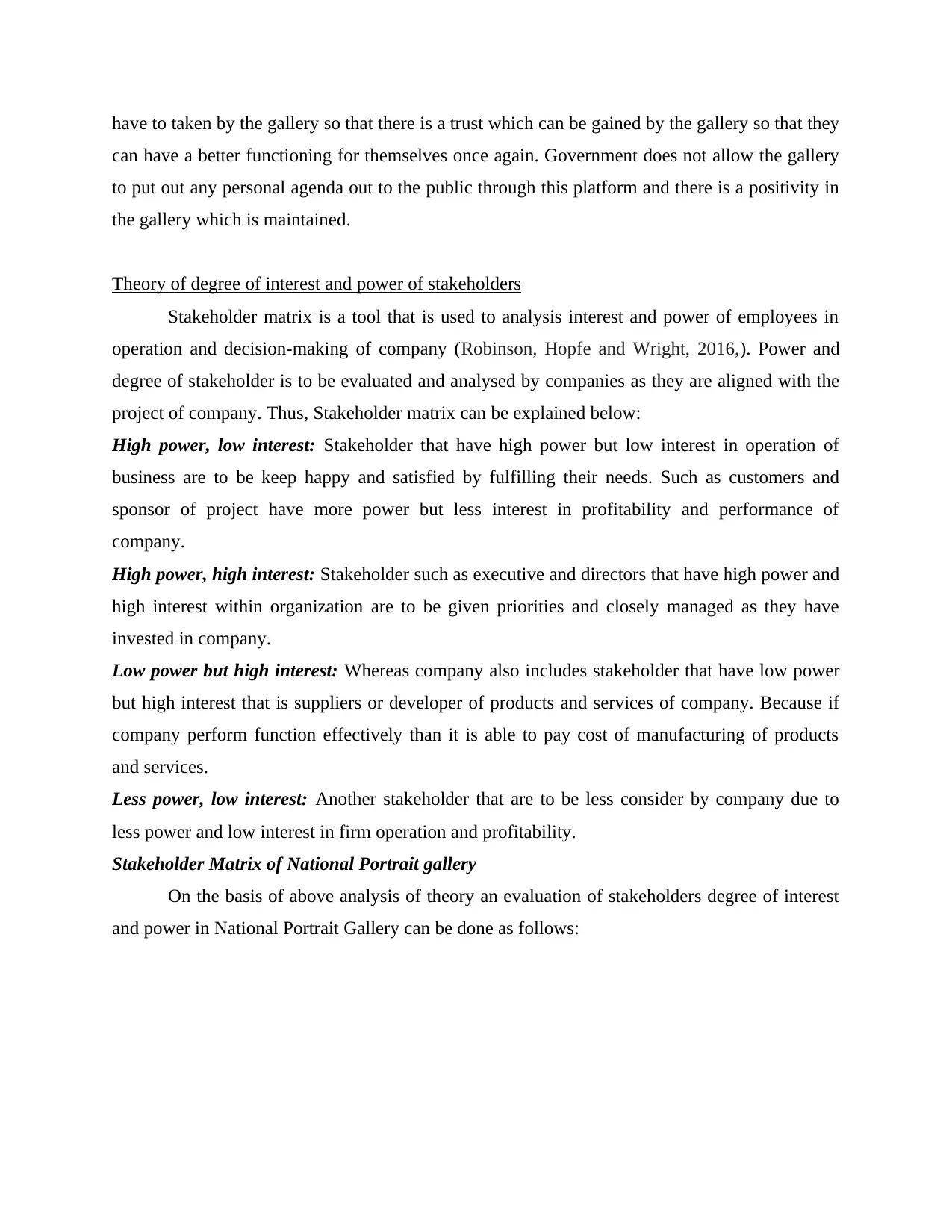
have to taken by the gallery so that there is a trust which can be gained by the gallery so that they
can have a better functioning for themselves once again. Government does not allow the gallery
to put out any personal agenda out to the public through this platform and there is a positivity in
the gallery which is maintained.
Theory of degree of interest and power of stakeholders
Stakeholder matrix is a tool that is used to analysis interest and power of employees in
operation and decision-making of company (Robinson, Hopfe and Wright, 2016,). Power and
degree of stakeholder is to be evaluated and analysed by companies as they are aligned with the
project of company. Thus, Stakeholder matrix can be explained below:
High power, low interest: Stakeholder that have high power but low interest in operation of
business are to be keep happy and satisfied by fulfilling their needs. Such as customers and
sponsor of project have more power but less interest in profitability and performance of
company.
High power, high interest: Stakeholder such as executive and directors that have high power and
high interest within organization are to be given priorities and closely managed as they have
invested in company.
Low power but high interest: Whereas company also includes stakeholder that have low power
but high interest that is suppliers or developer of products and services of company. Because if
company perform function effectively than it is able to pay cost of manufacturing of products
and services.
Less power, low interest: Another stakeholder that are to be less consider by company due to
less power and low interest in firm operation and profitability.
Stakeholder Matrix of National Portrait gallery
On the basis of above analysis of theory an evaluation of stakeholders degree of interest
and power in National Portrait Gallery can be done as follows:
can have a better functioning for themselves once again. Government does not allow the gallery
to put out any personal agenda out to the public through this platform and there is a positivity in
the gallery which is maintained.
Theory of degree of interest and power of stakeholders
Stakeholder matrix is a tool that is used to analysis interest and power of employees in
operation and decision-making of company (Robinson, Hopfe and Wright, 2016,). Power and
degree of stakeholder is to be evaluated and analysed by companies as they are aligned with the
project of company. Thus, Stakeholder matrix can be explained below:
High power, low interest: Stakeholder that have high power but low interest in operation of
business are to be keep happy and satisfied by fulfilling their needs. Such as customers and
sponsor of project have more power but less interest in profitability and performance of
company.
High power, high interest: Stakeholder such as executive and directors that have high power and
high interest within organization are to be given priorities and closely managed as they have
invested in company.
Low power but high interest: Whereas company also includes stakeholder that have low power
but high interest that is suppliers or developer of products and services of company. Because if
company perform function effectively than it is able to pay cost of manufacturing of products
and services.
Less power, low interest: Another stakeholder that are to be less consider by company due to
less power and low interest in firm operation and profitability.
Stakeholder Matrix of National Portrait gallery
On the basis of above analysis of theory an evaluation of stakeholders degree of interest
and power in National Portrait Gallery can be done as follows:
Paraphrase This Document
Need a fresh take? Get an instant paraphrase of this document with our AI Paraphraser
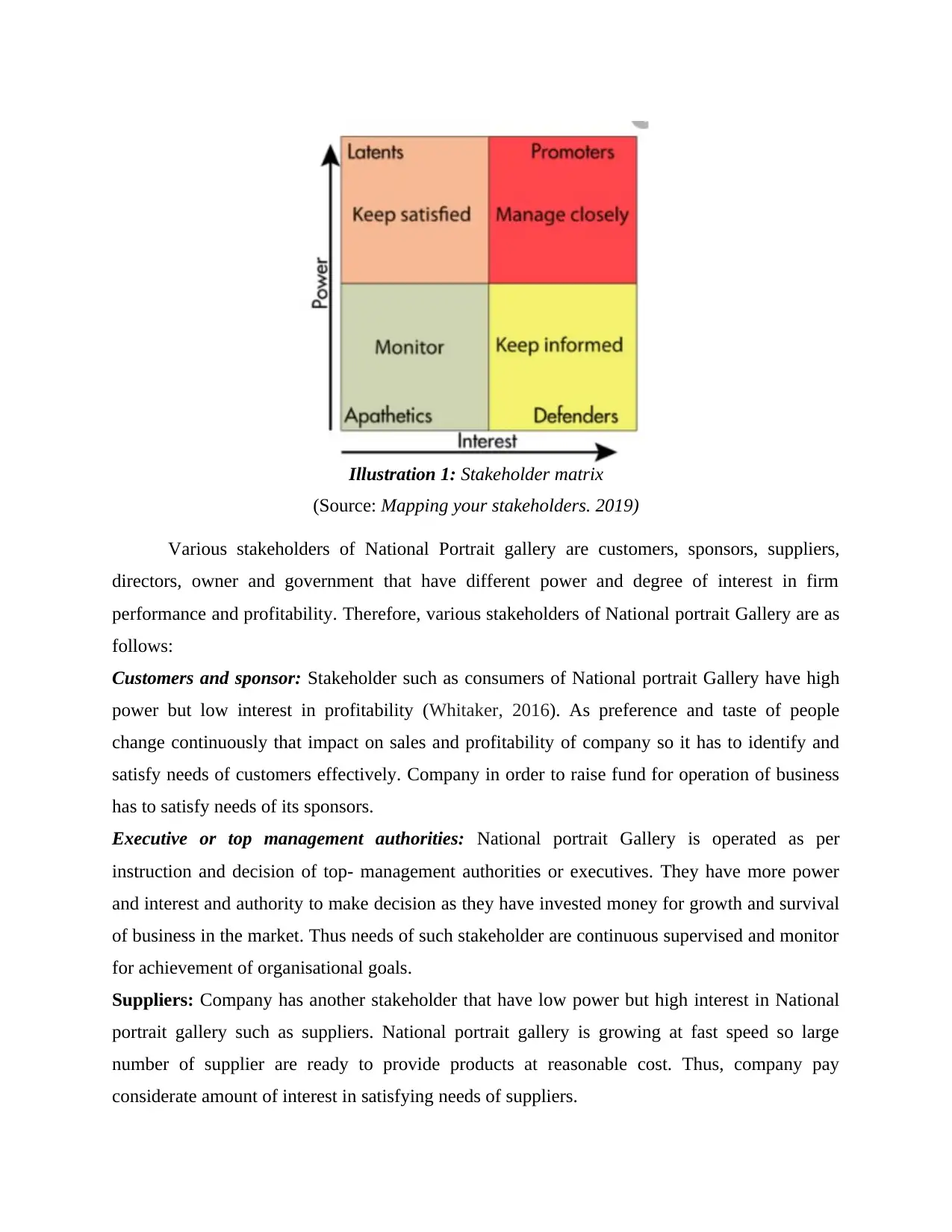
Various stakeholders of National Portrait gallery are customers, sponsors, suppliers,
directors, owner and government that have different power and degree of interest in firm
performance and profitability. Therefore, various stakeholders of National portrait Gallery are as
follows:
Customers and sponsor: Stakeholder such as consumers of National portrait Gallery have high
power but low interest in profitability (Whitaker, 2016). As preference and taste of people
change continuously that impact on sales and profitability of company so it has to identify and
satisfy needs of customers effectively. Company in order to raise fund for operation of business
has to satisfy needs of its sponsors.
Executive or top management authorities: National portrait Gallery is operated as per
instruction and decision of top- management authorities or executives. They have more power
and interest and authority to make decision as they have invested money for growth and survival
of business in the market. Thus needs of such stakeholder are continuous supervised and monitor
for achievement of organisational goals.
Suppliers: Company has another stakeholder that have low power but high interest in National
portrait gallery such as suppliers. National portrait gallery is growing at fast speed so large
number of supplier are ready to provide products at reasonable cost. Thus, company pay
considerate amount of interest in satisfying needs of suppliers.
Illustration 1: Stakeholder matrix
(Source: Mapping your stakeholders. 2019)
directors, owner and government that have different power and degree of interest in firm
performance and profitability. Therefore, various stakeholders of National portrait Gallery are as
follows:
Customers and sponsor: Stakeholder such as consumers of National portrait Gallery have high
power but low interest in profitability (Whitaker, 2016). As preference and taste of people
change continuously that impact on sales and profitability of company so it has to identify and
satisfy needs of customers effectively. Company in order to raise fund for operation of business
has to satisfy needs of its sponsors.
Executive or top management authorities: National portrait Gallery is operated as per
instruction and decision of top- management authorities or executives. They have more power
and interest and authority to make decision as they have invested money for growth and survival
of business in the market. Thus needs of such stakeholder are continuous supervised and monitor
for achievement of organisational goals.
Suppliers: Company has another stakeholder that have low power but high interest in National
portrait gallery such as suppliers. National portrait gallery is growing at fast speed so large
number of supplier are ready to provide products at reasonable cost. Thus, company pay
considerate amount of interest in satisfying needs of suppliers.
Illustration 1: Stakeholder matrix
(Source: Mapping your stakeholders. 2019)
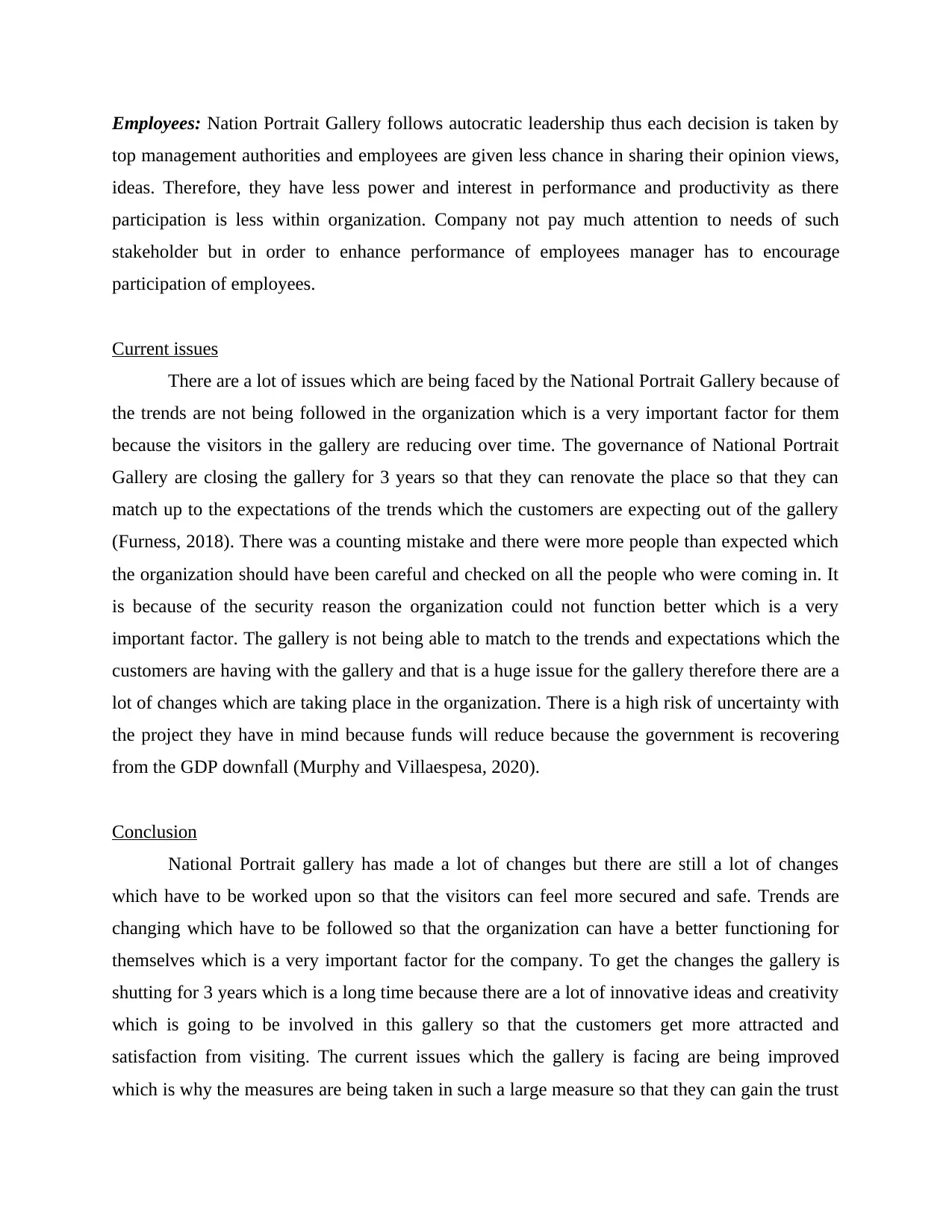
Employees: Nation Portrait Gallery follows autocratic leadership thus each decision is taken by
top management authorities and employees are given less chance in sharing their opinion views,
ideas. Therefore, they have less power and interest in performance and productivity as there
participation is less within organization. Company not pay much attention to needs of such
stakeholder but in order to enhance performance of employees manager has to encourage
participation of employees.
Current issues
There are a lot of issues which are being faced by the National Portrait Gallery because of
the trends are not being followed in the organization which is a very important factor for them
because the visitors in the gallery are reducing over time. The governance of National Portrait
Gallery are closing the gallery for 3 years so that they can renovate the place so that they can
match up to the expectations of the trends which the customers are expecting out of the gallery
(Furness, 2018). There was a counting mistake and there were more people than expected which
the organization should have been careful and checked on all the people who were coming in. It
is because of the security reason the organization could not function better which is a very
important factor. The gallery is not being able to match to the trends and expectations which the
customers are having with the gallery and that is a huge issue for the gallery therefore there are a
lot of changes which are taking place in the organization. There is a high risk of uncertainty with
the project they have in mind because funds will reduce because the government is recovering
from the GDP downfall (Murphy and Villaespesa, 2020).
Conclusion
National Portrait gallery has made a lot of changes but there are still a lot of changes
which have to be worked upon so that the visitors can feel more secured and safe. Trends are
changing which have to be followed so that the organization can have a better functioning for
themselves which is a very important factor for the company. To get the changes the gallery is
shutting for 3 years which is a long time because there are a lot of innovative ideas and creativity
which is going to be involved in this gallery so that the customers get more attracted and
satisfaction from visiting. The current issues which the gallery is facing are being improved
which is why the measures are being taken in such a large measure so that they can gain the trust
top management authorities and employees are given less chance in sharing their opinion views,
ideas. Therefore, they have less power and interest in performance and productivity as there
participation is less within organization. Company not pay much attention to needs of such
stakeholder but in order to enhance performance of employees manager has to encourage
participation of employees.
Current issues
There are a lot of issues which are being faced by the National Portrait Gallery because of
the trends are not being followed in the organization which is a very important factor for them
because the visitors in the gallery are reducing over time. The governance of National Portrait
Gallery are closing the gallery for 3 years so that they can renovate the place so that they can
match up to the expectations of the trends which the customers are expecting out of the gallery
(Furness, 2018). There was a counting mistake and there were more people than expected which
the organization should have been careful and checked on all the people who were coming in. It
is because of the security reason the organization could not function better which is a very
important factor. The gallery is not being able to match to the trends and expectations which the
customers are having with the gallery and that is a huge issue for the gallery therefore there are a
lot of changes which are taking place in the organization. There is a high risk of uncertainty with
the project they have in mind because funds will reduce because the government is recovering
from the GDP downfall (Murphy and Villaespesa, 2020).
Conclusion
National Portrait gallery has made a lot of changes but there are still a lot of changes
which have to be worked upon so that the visitors can feel more secured and safe. Trends are
changing which have to be followed so that the organization can have a better functioning for
themselves which is a very important factor for the company. To get the changes the gallery is
shutting for 3 years which is a long time because there are a lot of innovative ideas and creativity
which is going to be involved in this gallery so that the customers get more attracted and
satisfaction from visiting. The current issues which the gallery is facing are being improved
which is why the measures are being taken in such a large measure so that they can gain the trust
⊘ This is a preview!⊘
Do you want full access?
Subscribe today to unlock all pages.

Trusted by 1+ million students worldwide

of the visitors again. Improving the collection and developing the right staff since this is a huge
gallery in United Kingdom which is why there are a lot of changes which have to be made so
that the gallery can get more tourists to visit this location.
gallery in United Kingdom which is why there are a lot of changes which have to be made so
that the gallery can get more tourists to visit this location.
Paraphrase This Document
Need a fresh take? Get an instant paraphrase of this document with our AI Paraphraser
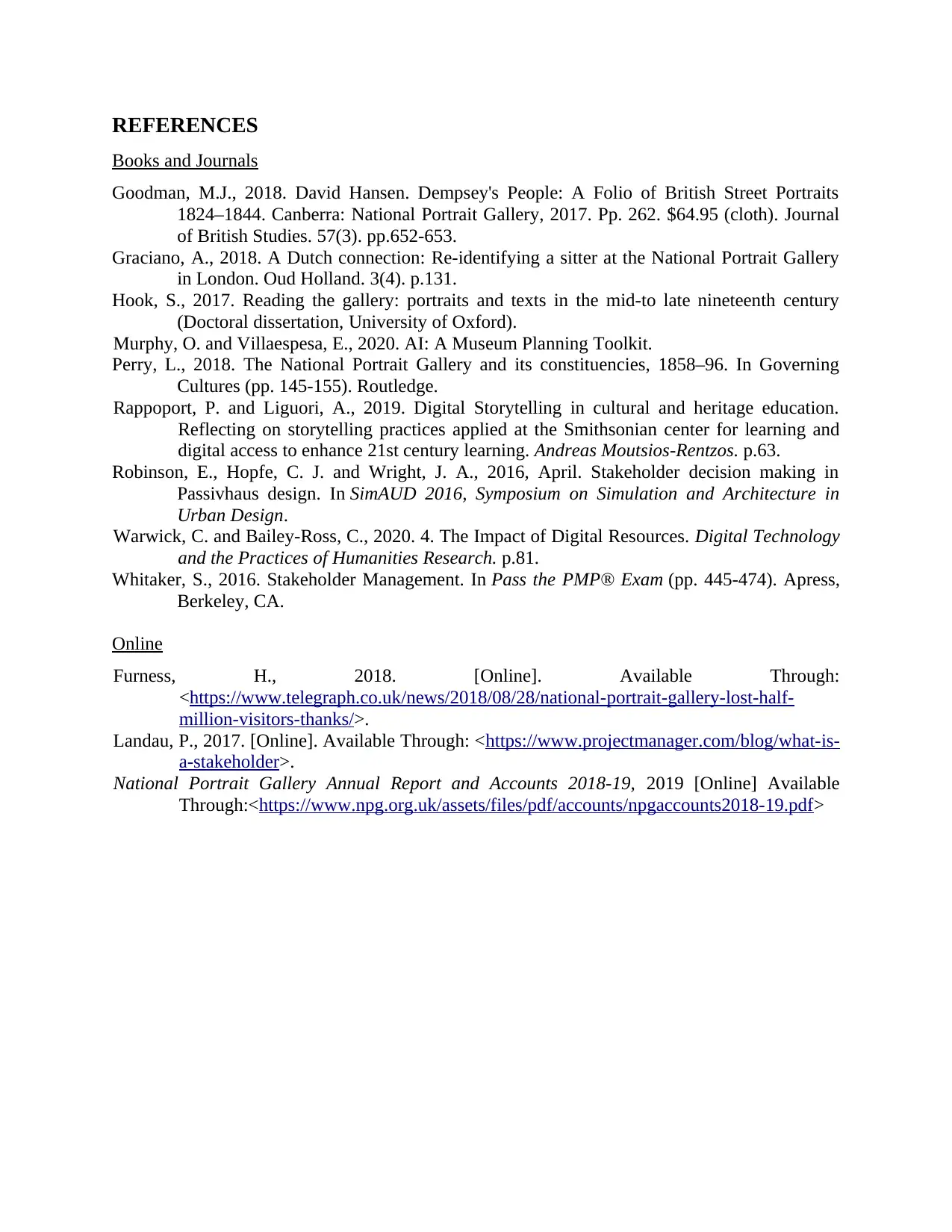
REFERENCES
Books and Journals
Goodman, M.J., 2018. David Hansen. Dempsey's People: A Folio of British Street Portraits
1824–1844. Canberra: National Portrait Gallery, 2017. Pp. 262. $64.95 (cloth). Journal
of British Studies. 57(3). pp.652-653.
Graciano, A., 2018. A Dutch connection: Re-identifying a sitter at the National Portrait Gallery
in London. Oud Holland. 3(4). p.131.
Hook, S., 2017. Reading the gallery: portraits and texts in the mid-to late nineteenth century
(Doctoral dissertation, University of Oxford).
Murphy, O. and Villaespesa, E., 2020. AI: A Museum Planning Toolkit.
Perry, L., 2018. The National Portrait Gallery and its constituencies, 1858–96. In Governing
Cultures (pp. 145-155). Routledge.
Rappoport, P. and Liguori, A., 2019. Digital Storytelling in cultural and heritage education.
Reflecting on storytelling practices applied at the Smithsonian center for learning and
digital access to enhance 21st century learning. Andreas Moutsios-Rentzos. p.63.
Robinson, E., Hopfe, C. J. and Wright, J. A., 2016, April. Stakeholder decision making in
Passivhaus design. In SimAUD 2016, Symposium on Simulation and Architecture in
Urban Design.
Warwick, C. and Bailey-Ross, C., 2020. 4. The Impact of Digital Resources. Digital Technology
and the Practices of Humanities Research. p.81.
Whitaker, S., 2016. Stakeholder Management. In Pass the PMP® Exam (pp. 445-474). Apress,
Berkeley, CA.
Online
Furness, H., 2018. [Online]. Available Through:
<https://www.telegraph.co.uk/news/2018/08/28/national-portrait-gallery-lost-half-
million-visitors-thanks/>.
Landau, P., 2017. [Online]. Available Through: <https://www.projectmanager.com/blog/what-is-
a-stakeholder>.
National Portrait Gallery Annual Report and Accounts 2018-19, 2019 [Online] Available
Through:<https://www.npg.org.uk/assets/files/pdf/accounts/npgaccounts2018-19.pdf>
Books and Journals
Goodman, M.J., 2018. David Hansen. Dempsey's People: A Folio of British Street Portraits
1824–1844. Canberra: National Portrait Gallery, 2017. Pp. 262. $64.95 (cloth). Journal
of British Studies. 57(3). pp.652-653.
Graciano, A., 2018. A Dutch connection: Re-identifying a sitter at the National Portrait Gallery
in London. Oud Holland. 3(4). p.131.
Hook, S., 2017. Reading the gallery: portraits and texts in the mid-to late nineteenth century
(Doctoral dissertation, University of Oxford).
Murphy, O. and Villaespesa, E., 2020. AI: A Museum Planning Toolkit.
Perry, L., 2018. The National Portrait Gallery and its constituencies, 1858–96. In Governing
Cultures (pp. 145-155). Routledge.
Rappoport, P. and Liguori, A., 2019. Digital Storytelling in cultural and heritage education.
Reflecting on storytelling practices applied at the Smithsonian center for learning and
digital access to enhance 21st century learning. Andreas Moutsios-Rentzos. p.63.
Robinson, E., Hopfe, C. J. and Wright, J. A., 2016, April. Stakeholder decision making in
Passivhaus design. In SimAUD 2016, Symposium on Simulation and Architecture in
Urban Design.
Warwick, C. and Bailey-Ross, C., 2020. 4. The Impact of Digital Resources. Digital Technology
and the Practices of Humanities Research. p.81.
Whitaker, S., 2016. Stakeholder Management. In Pass the PMP® Exam (pp. 445-474). Apress,
Berkeley, CA.
Online
Furness, H., 2018. [Online]. Available Through:
<https://www.telegraph.co.uk/news/2018/08/28/national-portrait-gallery-lost-half-
million-visitors-thanks/>.
Landau, P., 2017. [Online]. Available Through: <https://www.projectmanager.com/blog/what-is-
a-stakeholder>.
National Portrait Gallery Annual Report and Accounts 2018-19, 2019 [Online] Available
Through:<https://www.npg.org.uk/assets/files/pdf/accounts/npgaccounts2018-19.pdf>
1 out of 11
Related Documents
Your All-in-One AI-Powered Toolkit for Academic Success.
+13062052269
info@desklib.com
Available 24*7 on WhatsApp / Email
![[object Object]](/_next/static/media/star-bottom.7253800d.svg)
Unlock your academic potential
Copyright © 2020–2025 A2Z Services. All Rights Reserved. Developed and managed by ZUCOL.





